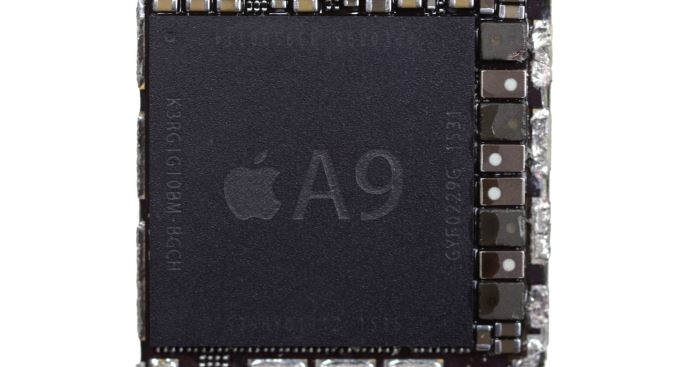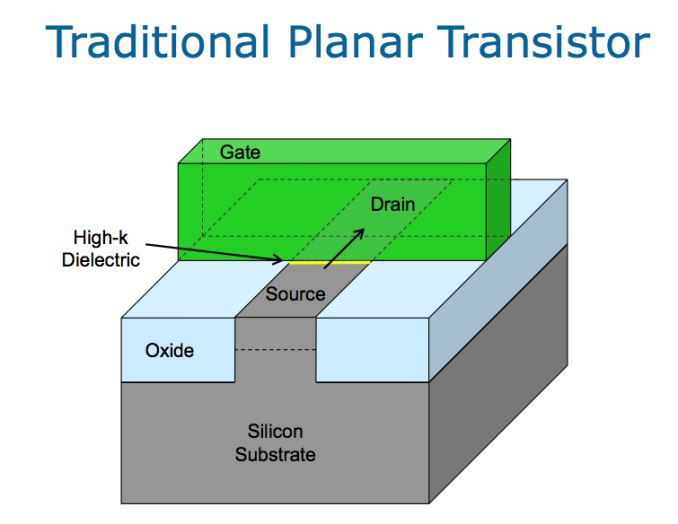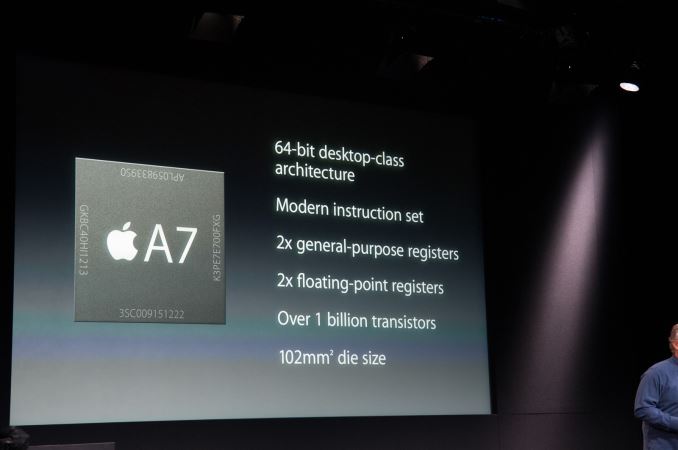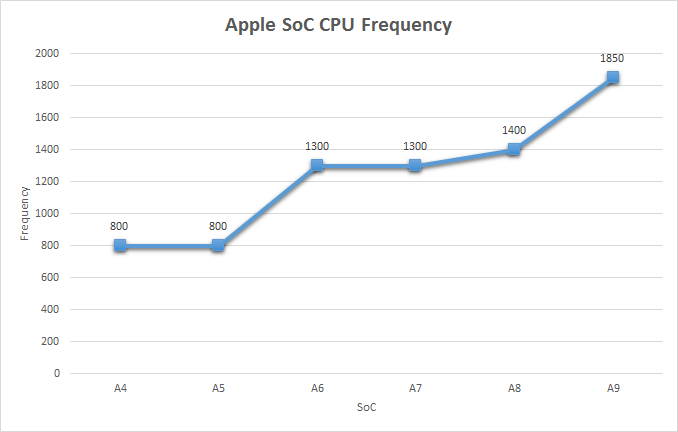The Apple iPhone 6s and iPhone 6s Plus Review
by Ryan Smith & Joshua Ho on November 2, 2015 8:00 AM EST- Posted in
- Smartphones
- Apple
- Mobile
- SoCs
- iPhone 6s
- iPhone 6s Plus
Analyzing Apple A9’s SoC
For Apple’s engineering teams, I’m still undecided whether Apple’s tick-tock style of SoC development is a curse or a blessing. That Apple more strongly invests in SoC development for the iPhone-S processors is a blessing, as it gives the engineering teams a bit of time to breathe and to plan out major architecture shifts over two years. On the other hand even for non-S iPhones the engineering teams still need to deliver an amazing product – iPhone 5 and iPhone 6 were no slouches – so I’m not sure how much of a breather the engineering teams actually get. They may have two years to space some of their transitions, but they must continue to deliver a top-tier SoC every year.
When Apple released the A7 SoC alongside the iPhone 5s in 2013, they pulled off something that rocked the SoC industry. The Cyclone CPU core all but came out of nowhere, beating previous estimates for the first ARMv8 64-bit phone SoCs (by any vendor) by roughly a year. As a result the 64-bit transition became a lot more important a lot sooner than anyone was expecting, and to this date some of Apple’s SoC competitors are still trying to recover from the shock of having to scramble to go 64-bit sooner than they planned.
As for Apple’s engineering teams, that we’re on another iPhone-S year means that there’s quite a bit of pressure to pull off a repeat performance, and I suspect that pressure is internal as much as it is external. A7 brought with it Cyclone, a CPU that was not only 64-bit, but thanks to its exceptional (for a mobile CPU) issue width of 6 micro-ops, brought with it a huge jump in single-threaded performance. At the same time A7 also saw Apple transition to PowerVR’s Rogue architecture GPUs (PowerVR G6xxx), which was a similar jump in GPU capabilities and performance, along with setting the stage for Apple’s proprietary, low-level Metal graphics API. A7 was everything Apple needed and more, cementing Apple’s place as a top-tier SoC designer and laying the groundwork for the performance advantage Apple has enjoyed over the past two years.

Apple's A9 SoC (Image Courtesy iFixit)
For 2015 then and for their latest iPhone-S, Apple has once again turned out a new SoC. This brings us to the A9, and in a year with an iPhone-S and almost no external design changes to speak of, all eyes are on what Apple has devised to go inside their phones.
| Apple A9 vs A8 SoCs | ||||
| Apple A9 (2015) | Apple A8 (2014) | |||
| Manufacturing Process | TSMC 16nm FinFET / Samsung 14nm FinFET |
TSMC 20nm HKMG | ||
| Die Size | 104.5mm2/96mm2 | 89mm2 | ||
| CPU | 2 x Apple Twister ARMv8 64-bit cores |
2 x Apple Typhoon ARMv8 64-bit cores |
||
| GPU | IMG PowerVR GT7600 | IMG PowerVR GX6450 | ||
Finally Fabbed with FinFETs
When the iPhone 6 launched I spent some time talking about how for the A8 SoC, Apple finally reached the point where they were building SoCs on a leading edge manufacturing process. That process at the time being TSMC’s 20nm planar process. The fact that Apple was building on a leading edge process was important for two reasons: 1) It was a strong indicator of how serious they were about SoC production and how much they were willing to spend in order to achieve the best possible performance, and 2) it meant that Apple had finally completely climbed the ladder (so to speak) and wouldn’t be able to “exceed the curve” just by catching up on manufacturing technology. Post-A8, Apple can only improve their performance by improving their architecture, building bigger chips, and finally, jumping to newer manufacturing processes as they become available.
What wasn’t said at the time – due to the fact that no one outside the fabs was quite sure – was where Apple would go in 2015. Had you asked me in 2014 what I would expect the A9 to be fabbed on, I would have suggested another round on TSMC’s 20nm process now that Apple had caught up to the leading edge. However much to my surprise (and to a steak dinner I lost a bet on) Samsung was able to get their 14nm FinFET process yielding well enough to supply Exynos 7420 in bulk for the Galaxy S6 launch nearly 6 months ago.
The fact that one of the contract fabs was able to get a FinFET process up and yielding well enough for volume production before the very end of 2015 has definitely changed the picture for what Apple can do. Once again they get to jump to a new manufacturing process for their next SoC, though this time by staying on the leading edge.


Planar vs. FinFET (3D) Transistors (via Intel)
While I’m not going to go into the physics of FinFET in depth here – we have some great articles on that already – I do want to quickly touch upon why this is so important. 14nm (and 16nm) FinFET isn’t just a new manufacturing node, but it’s part of a broader change in how transistors are manufactured. Simply put, FinFET (aka 3D transistors) are a long in development technology meant to help transistors scale to increasingly small scales, on the order of dozens of atoms or less.
FinFET transistors are necessary because as transistors get smaller their leakage (wasted power) goes up, and without FinFETs leakage would spiral out of control. In fact that’s exactly what happened on the 20nm nodes from Samsung and TSMC; both companies thought the leakage of planar transistors could be adequately controlled at 20nm, only for leakage to be a bigger problem than they expected. Due in large part to this reason, the 20nm SoCs released over the last 18 months have more often than not struggled with power consumption and heat, especially at higher clockspeeds. Apple is something of the exception here, with the 20nm A8 proving to be a solid SoC, thanks in part to their wide CPU design allowing them to achieve good performance without using high clockspeeds that would exacerbate the problem.
That said, while Apple managed to handle 20nm well enough, they were still ultimately at the mercy of a subpar process. The 14nm/16nm FinFET processes are what 20nm should have been all along, with the use of FinFETs drastically cutting down on leakage and reducing operating voltages – and now that FinFETs are here Apple no longer has to be as conservative as they were with A8. What that gives Apple then is a chance to push the envelope much harder on clockspeeds, taking their already wide CPU designs and turning up the clockspeeds as well.












531 Comments
View All Comments
flyingfiddle - Wednesday, November 4, 2015 - link
Truly amazed and convinced that Apple has the best SoC of any phones, and their investment on the SoC paid off. So does their investment on refined iOS experience. I am Android guy but I have to admit I really wish SoC on Android could catch up one day, sooner the better.On the other hand, just because Apple is great in some areas does not mean they should get away with other things that's not as great. The raw power of a high end phone has become more than sufficient for many general users, such that making it more powerful is starting to generate diminished return. I could think of many things that I wish iPhone has, such as longer battery life (i know it's great, relatively, but why not push the boundary?), better screen/body ratio, external memory, more setting and better UI in the camera app, etc.
Well, still not my cup of tea but truly wish Android SoC could catch up one day. That's assuming Android platform survive that long (they have the largest market share but really don't make much money). I hope my money helps supporting them a bit longer..
tytung - Wednesday, November 4, 2015 - link
Can anyone comment on the iPhone 6s Plus frame rate dropping issue ? Animations looks choppy and the frame rate looks like only about 30 fps, unlike 60 fps on the 6s. If the GPU on the phone is so powerful this should not be an issue. In fact, for a phone this expensive UI frame rate drop is really a shameful problem.polmes - Thursday, November 5, 2015 - link
Got tired of iOS and moved to Android (Galaxy S6) earlier this year, but Apple definitely deserves an applause for being basically the only one to keep innovating in the mobile space. kudosSocius - Thursday, November 5, 2015 - link
Hmmmm...any idea why your iPhone 6s Plus scored just 15800 in Google octane when mine scored over 18,000? That's a pretty big discrepancy at 15%. Does your phone have a Samsung CPU? Mine is TSMC.zeeBomb - Thursday, November 5, 2015 - link
Both units are TSMC.Socius - Thursday, November 5, 2015 - link
Then there's something off as there is no way the 6s plus should be scoring just 15,800 on octane.mortimerr - Thursday, November 5, 2015 - link
I've never actually owned an Apple product in my life. All the way back to the original iPod classic. But I will probably finally be changing my stupid principle of 'No Apple Products'.The Android landscape recently has been going back instead of forward. Android 5-6 showcase minor improvements over 4.4.4 (Personally I also prefer Halo. Marshmallow and Lollipop looks slightly cartoony), battery life isn't that much of a leap (a lot of devices are experiencing the mobile radio active bug), and due to the fact that the high end market in the East is so saturated, most OEMs are cutting costs and putting out mid tier phones that lack top end hardware.
A lot of recent releases for Android have a great price point but either have a terrible camera (sensor, pixel size, post processing etc) or the IPS display leaves something to be desired, or it's this or it's that. The only OEM pushing the platform forward is Samsung. But, to be quite frank, I find those devices ugly to look at in every way from the bezel, UI skin, back, front, etc.
Where as Apple continues to simply improve with every iteration. Dual source fab at 14nm! What? 3D touch, increasing the ppi, maintaining solid battery life, great low light camera performance. Offering a big size and a small size with the same internals.
Sony also did this but I don't see the 810 as a very good chip going forward. Especially when it's already pretty far behind in performance to the Exynos and A#. I'll look forward to see if Sony updates the Z line.
I want to wait for Q2'16 for when devices with the 820 start being released, but what's the point when every device will inevitably have some drawback or large flaw or straight up just not be released in N. America.
JTRCK - Friday, November 6, 2015 - link
Where do you want phones to go? There's not much else they can do. A phone being imperfect is "always" the case. There is always something lacking in all these devices, including the iPhone 6S and 6S Plus. One of the first mentions in this review is that the author is still using an HTC One M7 from years ago. Because quite honestly, that was the pinnacle of smartphone design plus an excellent combination of fluid software, excellent performance, and an excellent night performance for a camera (though everything else about that camera was a downgrade). That 3 year old phone is still a very good performer today.Increasing processor/RAM/Storage speed is all excellent and it's expected, but the benefits from such increases are hardly felt by the user on day to day usage. Especially if the software is done properly. Example: I have an old iPhone 4s at home that I use for music streaming that consistently beat out my previous note 4 on application opening, multitasking, sound output quality, web surfing speed, etc. Which phone is superior? Which phone is better? Did AnandTech give that iPhone 4s the BEST award? In my view Apple has always been the king of software and hardware performance. They can get a device with 512mb of ram to outperform a Note 4 with a multicore processor and with 3GB of ram. They should always get the BEST award. But is the BEST (100%) really worth $1,200.00 when the second BEST (99%) is half the price?
I'm not talking about Samsung here. Their phones are expensive with crappy performance. I'm talking about the Moto X Pure, HTC One M9/10, Nexus 6P, etc. I used an iPhone 6S Plus for 2 weeks (and an iPhone 6 Plus for 4 months before that) and returned it for the Nexus 6P. I find the 6P to be a much better phone than the iPhone 6S plus in almost every aspect. It charges faster, it opens applications just as fast, I can multitask faster with the 6P with a side launcher without ever having to see a home screen. I can transition within an app at a faster pace due to dedicated back buttons. A simple thing as not having a "button" to go back a task annoyed me to no end with the iPhone. Not to mention all the limitations of iOS. The only benefit of iPhone for me were the integrations with my Macbook, but other than that. I disliked both iPhones.
The iPhone has all this amazing technology at its core, but my grandmother would never know when using her new 6S. And that's how it should be. I'm more amazed that a Nexus 6P costs half what an iPhone costs while still managing to do just as much, if not more. I honestly found nothing revolutionary about the 6S Plus while using it. In fact, I found it to be quite similar to the 6 Plus. Which I found to be quite similar to the iPhone 4s. Just much larger. And in terms of OS performance, vanilla android at this point is quite simply just as visually pleasing, power efficient, responsive and performant as iOS.
FL777 - Friday, November 6, 2015 - link
Amusingly, there is a YouTube real world speed test between the Nexus 6P and the iPhone 6S and the Nexus 6P BEATS THE IPHONE 6S!!!!!http://www.frequency.com/video/nexus-6p-vs-iphone-...
So much for the iPhone 6S SoC being unbeatable LOL.
Blark64 - Friday, November 6, 2015 - link
Umm, did you watch the video? The difference was milliseconds, and with a "hand-done" test like this the phones were well within the margin of error, and essentially tied. Also, that was possibly the least informative benchmark I've ever seen, since repeatedly launching apps in a tight cycle is something that essentially no one actually does in the real world. That's why benchmarks that are either: more reflective of the real world, or synthetic and scientifically repeatable (like Geekbench and the various browser benchmarks), are probably a better guide.